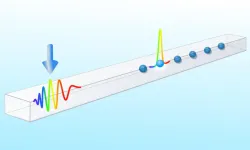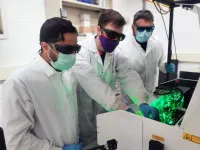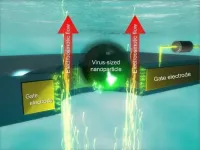(Press-News.org) Light-emitting diodes (LEDs) have revolutionized the displays industry. LEDs use electric current to produce visible light without the excess heat found in traditional light bulbs, a glow called electroluminescence. This breakthrough led to the eye-popping, high-definition viewing experience we've come to expect from our screens. Now, a group of physicists and chemists have developed a new type of LED that utilizes spintronics without needing a magnetic field, magnetic materials or cryogenic temperatures; a "quantum leap" that could take displays to the next level.
"The companies that make LEDs or TV and computer displays don't want to deal with magnetic fields and magnetic materials. It's heavy and expensive to do it," said Valy Vardeny, distinguished professor of physics and astronomy at the University of Utah. "Here, chiral molecules are self-assembled into standing arrays, like soldiers, that actively spin polarize the injected electrons, which subsequently lead to circularly polarized light emission. With no magnetic field, expensive ferromagnets and with no need for extremely low temperatures. Those are no-nos for the industry."
Most opto-electronic devices, such as LEDs, only control charge and light and not the spin of the electrons. The electrons possess tiny magnetic fields that, like the Earth, have magnetic poles on opposite sides. Its spin may be viewed as the orientation of the poles and can be assigned binary information--an "up" spin is a "1," a "down" is a "0." In contrast, conventional electronics only transmit information through bursts of electrons along a conductive wire to convey messages in "1s" and "0s." Spintronic devices, however, could utilize both methods, promising to process exponentially more information than traditional electronics.
One barrier to commercial spintronics is setting the electron spin. Presently, one needs to produce a magnetic field to orient the electron spin direction. Researchers from the University of Utah and the National Renewable Energy Laboratory (NREL) developed technology that acts as an active spin filter made of two layers of material called chiral two-dimension metal-halide perovskites. The first layer blocks electrons having spin in the wrong direction, a layer that the authors call a chiral-induced spin filter. Then when the remaining electrons pass through the second light-emitting perovskite layer, they cause the layer to produce photons that move in unison along a spiral path, rather than a conventional wave pattern, to produce circular polarized electroluminescence.
The study was published in the journal Science on March 12, 2021.
Left-handed, right-handed molecules
The scientists exploited a property called chirality that describes a particular type of geometry. Human hands are a classic example; the right and left hands are arranged as mirrors of one another, but they will never perfectly align, no matter the orientation. Some compounds, such as DNA, sugar and chiral metal-halide perovskites, have their atoms arranged in a chiral symmetry. A "left-handed" oriented chiral system may allow transport of electrons with "up" spins but block electrons with "down" spins, and vice versa.
"If you try to transport electrons through these compounds, then the electron spin becomes aligned with the chirality of the material," Vardeny said. Other spin filters do exist, but they either require some kind of magnetic field, or they can only manipulate electrons in a small area. "The beauty of the perovskite material that we used is that it's two-dimensional--you can prepare many planes of 1 cm2 area that contain one million of a billion (1015) standing molecules with the same chirality."
Metal-halide perovskite semiconductors are mostly used for solar cells these days, as they are highly efficient at converting sunlight to electricity. Since a solar cell is one of the most demanding applications of any semiconductor, scientists are discovering other uses exist as well, including spin-LEDs.
"We are exploring the fundamental properties of metal-halide perovskites, which has allowed us to discover new applications beyond photovoltaics," said Joseph Luther, a co-author of the new paper and NREL scientist. "Because metal-halide perovskites, and other related metal halide organic hybrids, are some of the most fascinating semiconductors, they exhibit a host of novel phenomena that can be utilized in transforming energy."
Although metal-halide perovskites are the first to prove the chiral-hybrid devices are feasible, they are not the only candidates for spin-LEDs. The general formula for the active spin filter is one layer of an organic, chiral material, another layer of an inorganic metal halide, such as lead iodine, another organic layer, inorganic layer and so on.
"That's beautiful. I'd love that someone will come out with another 2-D organic/inorganic layer material that may do a similar thing. At this stage, it's very general. I'm sure that with time, someone will find a different two-dimensional chiral material that will be even more efficient," Vardeny said.
The concept proves that using these two dimensional chiral-hybrid systems gain control over spin without magnets and has "broad implications for applications such as quantum-based optical computing, bioencoding and tomography," according to Matthew Beard, a senior research fellow and director of Center for Hybrid Organic Inorganic Semiconductors for Energy.
INFORMATION:
Vardeny and Xin Pan from the Department of Physics & Astronomy at the University of Utah co-authored the study. The other co-authors from NREL are Beard, Young-Hoon Kim, Yaxin Zhai, Haipeng Lu, Chuanxiao Xiao, E. Ashley Gaulding, Steven Harvey and Joseph Berry. All are part of CHOISE collaboration, an Energy Frontier Research Center (EFRC) funded by the Office of Science within DOE.
Funding for the research came from CHOISE.
TOKYO - Toshiba Corporation (TOKYO: 6502), the industry leader in solutions for large-scale optimization problems, today announced a scale-out technology that minimizes hardware limitations, an evolution of its optimization computer, the Simulation Bifurcation Machine (SBM), that supports continued increases in computing speed and scale. Toshiba expects the new SBM to be a game changer for real-world problems that require large-scale, high-speed and low-latency, such as simultaneous financial transactions involving large numbers of stock, and complex control of multiple robots. The research results were published in Nature Electronics*1 on March 1.
Speed and scale are keys to success in industrial sectors ...
Waste cooking oil, sulfur and wool offcuts have been put to good use by green chemists at Flinders University to produce a sustainable new kind of housing insulation material.
The latest environmentally friendly building product from experts at the Flinders Chalker Lab and colleagues at Deakin and Liverpool University, has been described in a new paper published in Chemistry Europe ahead of Global Recycling Day (18 March 2021)
The insulating composite was made from the sustainable building blocks of wool fires, sulfur, and canola oil to produce a promising new model for next-generation insulation - not only capitalising on wool's natural low flammability but also to make significant energy savings for property owners and tenants.
The new composite is one of several exciting ...
Magnetic reconnection refers to the reconfiguration of magnetic field geometry. It plays an elemental role in the rapid release of magnetic energy and its conversion to other forms of energy in magnetized plasma systems throughout the universe.
Researchers led by Dr. LI Leping from the National Astronomical Observatories of the Chinese Academy of Sciences (NAOC) analyzed the evolution of magnetic reconnection and its nearby filament. The result suggested that reconnection is significantly accelerated by the propagating disturbance caused by the adjacent filament eruption.
The study was published in The Astrophysical Journal on Feb. 25.
The New Vacuum Solar Telescope (NVST) is a ...
In order to exploit the properties of quantum physics technologically, quantum objects and their interaction must be precisely controlled. In many cases, this is done using light. Researchers at the University of Innsbruck and the Institute of Quantum Optics and Quantum Information (IQOQI) of the Austrian Academy of Sciences have now developed a method to individually address quantum emitters using tailored light pulses. "Not only is it important to individually control and read the state of the emitters," says Oriol Romero-Isart, "but also to do so while leaving the system as undisturbed as possible." Together with Juan Jose? Garci?a-Ripoll (IQOQI visiting fellow) from the Instituto de Fi?sica Fundamental in Madrid, Romero-Isart's research group has ...
CLEMSON, South Carolina -- By using laser spectroscopy in a photophysics experiment, Clemson University researchers have broken new ground that could result in faster and cheaper energy to power electronics.
This novel approach, using solution-processed perovskite, is intended to revolutionize a variety of everyday objects such as solar cells, LEDs, photodetectors for smart phones and computer chips. Solution-processed perovskite are the next generation materials for solar cell panels on rooftops, X-ray detectors for medical diagnosis, and LEDs for daily-life lighting.
The research team included ...
A multiyear workplace health promotion program can slow down the increase in health risks for working-age people. A study by the Faculty of Sport and Health Sciences at the University of Jyväskylä followed what kind of changes happened among participants during an eight-year workplace health promotion program in smoking, minor exercise, high blood pressure, musculoskeletal disorders, and overweight. The results of the study were encouraging for health promotion.
According to earlier studies, a high number of health risks are connected to an increase in occupational health care costs, lower productivity at work, and the growing number of sickness ...
CLEVELAND--Scientists at the Case Western Reserve University School of Medicine have determined the structure of protein "fibrils" linked to Lou Gehrig's disease and other neurodegenerative disorders--findings that provide clues to how toxic proteins clump and spread between nerve cells in the brain.
Their results may also lead to developing drugs to treat diseases such as amyotrophic lateral sclerosis (ALS) and frontotemporal dementia (FTD).
"These devastating brain disorders that affect tens of thousands of Americans?are on the rise worldwide, and there are no effective treatments to ...
Researchers at Tufts University School of Engineering have created light-activated composite devices able to execute precise, visible movements and form complex three-dimensional shapes without the need for wires or other actuating materials or energy sources. The design combines programmable photonic crystals with an elastomeric composite that can be engineered at the macro and nano scale to respond to illumination.
The research provides new avenues for the development of smart light-driven systems such as high-efficiency, self-aligning solar cells that automatically follow the sun's direction and angle of light, light-actuated microfluidic valves or soft robots that move with light on demand. A "photonic sunflower," whose petals curl ...
A new study led by University of Maryland and UCLA researchers found that DNA from tissue samples can be used to accurately predict the age of bats in the wild. The study also showed age-related changes to the DNA of long-lived species are different from those in short-lived species, especially in regions of the genome near genes associated with cancer and immunity. This work provides new insight into causes of age-related declines.
This is the first research paper to show that animals in the wild can be accurately aged using an epigenetic clock, which predicts age based on specific changes to DNA. This work ...
Osaka, Japan - Scientists from the Institute of Scientific and Industrial Research at Osaka University fabricated nanopores in silicon dioxide, that were only 300 nm, in diameter surrounded by electrodes. These nanopores could prevent particles from entering just by applying a voltage, which may permit the development of sensors that can detect very small concentrations of target molecules, as well as next-generation DNA sequencing technology.
Nanopores are tiny holes that are wide enough for just a single molecule or particle to pass through. The motion of nanoparticles through these holes ...








